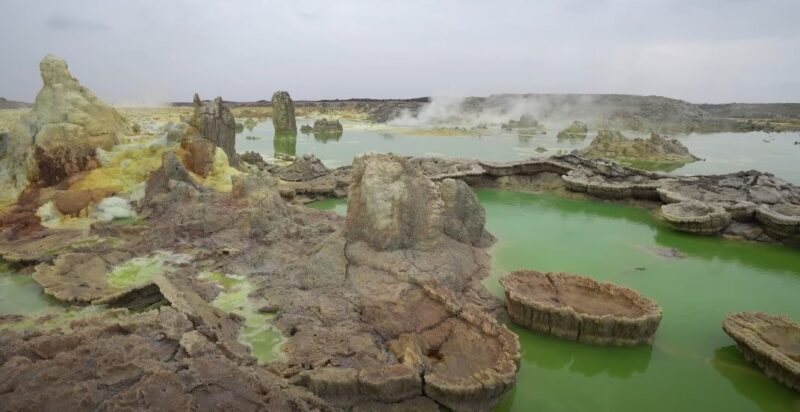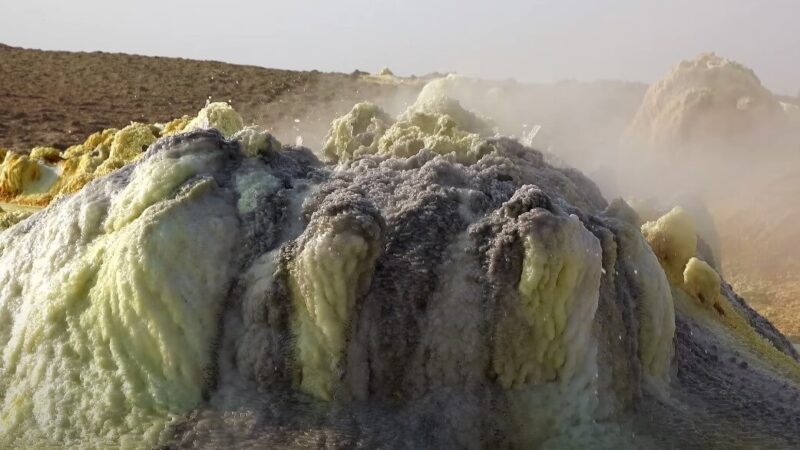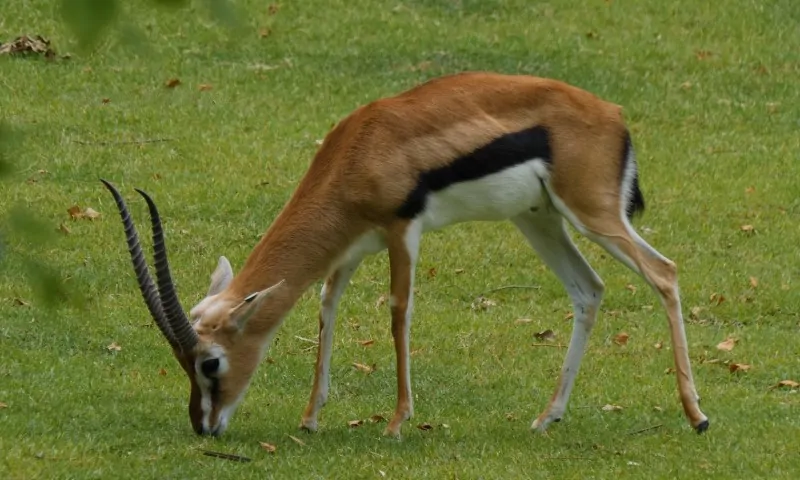When someone first told me about the Danakil Depression, my imagination ran wild. How could a place on Earth be so extreme, so harsh, that it’s often described as more alien than earthly?
The Danakil Depression, located in northeastern Ethiopia, isn’t just the hottest place on the planet—it’s a place where the Earth itself seems to be alive, constantly shifting, and reshaping itself in ways that are as awe-inspiring as they are terrifying.
Table of Contents
ToggleThe Scorching Heart of the Afar Region
Picture a vast, sun-blasted landscape, lying more than 100 meters below sea level, where temperatures can soar to an almost unbearable 55°C (131°F). The air shimmers with heat, and the ground beneath your feet feels like it might melt at any moment.
It’s hard to believe that anything can survive here, let alone thrive. Yet, in the heart of the Afar Region, the Danakil Depression endures, a testament to the resilience of life and the incredible forces of nature.
The Fascinating Geology of the Afar Triangle
What makes the Danakil Depression so unique isn’t just its heat—it’s the intense geological activity that has shaped the area over millions of years. The depression is part of the Afar Triangle, a point where three tectonic plates—the African, Arabian, and Indian—are slowly pulling away from each other.
This movement has created a rift valley that’s still widening, and as the plates drift apart, the landscape continues to evolve. I’ve always found geology fascinating, but seeing it in action here is something else entirely. The ground is alive with volcanic activity.
The Dallol volcano, which first erupted in 1926, is still active, and the Erta Ale volcano, with its continuously bubbling lava lake, feels like something out of a science fiction movie.
Standing on the edge of that lava lake, feeling the heat on your face, and hearing the low rumble of the Earth beneath you—it’s an experience that’s hard to put into words.
Life in the Danakil Depression

One of the most surprising things about the Danakil Depression is that, despite its inhospitable environment, life finds a way. The area is home to extremophiles—microorganisms that not only survive but thrive in extreme conditions.
These tiny, ancient life forms live in places where toxic gases fill the air, and the ground is so hot you could cook an egg on it. It’s humbling to think that life is so adaptable, so tenacious, that it can survive where almost nothing else can.
The landscape itself is also a wonder. In the Dallol region, the ground is dotted with colorful hydrothermal pools and sulfurous springs. The minerals in the water create vibrant yellows, oranges, and greens that are almost too bright to be real.
Walking through this area feels like stepping onto another planet. The air smells of sulfur, and the ground crunches underfoot as you navigate between the pools. It’s beautiful in a way that’s both mesmerizing and slightly eerie.
The Afar People

But it’s not just the microorganisms that have adapted to life in the Danakil Depression. The Afar people have lived here for millennia, their lives intertwined with this harsh landscape in ways that are both remarkable and inspiring.
Despite the brutal heat and the constant threat of volcanic activity, the Afar have managed to carve out a life for themselves in this extreme environment. One of the main economic activities in the region is salt mining, a practice that has been passed down through generations.
The Afar people extract salt from vast salt flats using traditional methods, working in temperatures that would drive most of us to seek shade—or better yet, an air-conditioned room.
Watching them work, it’s clear that their relationship with the land is one of deep respect and understanding. The salt they harvest is then transported by camel caravans across the desert, a grueling journey that highlights the resilience and endurance of the Afar people.
The Challenge and Reward of Visiting the Danakil Depression

For those of us drawn to the world’s extremes, the Danakil Depression offers an adventure like no other. But it’s not a journey to be taken lightly. Visiting this region requires careful preparation.
The heat is relentless, the terrain is unforgiving, and the environment can be downright dangerous. Toxic fumes from the volcanic activity are a real concern, and the loose sand can make walking difficult, even for the most seasoned traveler.
Most tours start in the city of Mekele, a bustling hub where you can find guides who know the area well. From there, it’s a long, hot drive into the depression, with stops at some of the most iconic sites along the way.
Erta Ale’s lava lake is usually the highlight of the trip, but the salt flats of Lake Karum (also known as Lake Asale) and the otherworldly hydrothermal fields of Dallol are equally unforgettable. One of the most striking things about the Danakil Depression is the sheer isolation.
There are no modern amenities out here—no hotels, no restaurants, no Wi-Fi. It’s just you, your fellow travelers, and the vast, unforgiving landscape. But that’s part of the appeal.
In a world where we’re constantly connected, constantly bombarded with information, the silence and solitude of the Danakil Depression are an unusual form of escape, the one that some may find pretty attractive.
Looking Ahead
What does the future hold for this extraordinary place? The geological processes that created the Danakil Depression are still at work, and as the tectonic plates continue to move, the landscape will keep changing.
Some scientists believe that in a few million years, the Red Sea will flood the area, creating a new ocean where the Danakil Depression once stood. But for now, the depression remains a place of stark natural beauty and scientific interest.
Researchers come here to study the extremophiles, hoping to learn more about how life can survive in such extreme conditions. Adventurers come for the thrill of exploring one of the most inhospitable places on Earth. And the Afar people continue to live and work in the region, their lives shaped by the rhythms of the land.
Fun Facts About Danakil Depression

- Hottest Place on Earth: The Danakil Depression is renowned as one of the hottest places on the planet, with average temperatures reaching as high as 34.4°C (94°F) and sometimes soaring above 50°C (122°F).
- Below Sea Level: It is one of the lowest places on Earth, sitting around 125 meters (410 feet) below sea level. This geological depression is the result of the continental drift of three tectonic plates.
- Unique Geological Features: The area is famous for its alien-like landscape, including salt lakes, lava lakes, active volcanoes, and colorful acidic springs. The bright colors come from the mineral deposits and the extreme heat.
- Salt Mining: The depression has been a site for salt mining for centuries. The Afar people still use traditional methods to mine and transport salt, often using camel caravans.
- Volcanic Activity: The region is home to the Erta Ale volcano, which has one of the few continuously active lava lakes in the world. The volcanic activity contributes to the region’s unique and dramatic landscape.
- Afar Triangle: The Danakil Depression is part of the larger Afar Triangle, a geological feature where the African, Arabian, and Somali tectonic plates meet, leading to intense volcanic activity and the creation of rift valleys.
- Harsh Living Conditions: Despite its harsh environment, the Danakil Depression is inhabited by the Afar people, who have adapted to the extreme conditions over centuries.
Why the Danakil Depression Matters
The Danakil Depression isn’t just a curiosity, a footnote in a travel guide. It’s a place that challenges our ideas about what life can endure and what the Earth itself is capable of.
It’s a place that forces you to confront your own limitations, to push through discomfort and fear, and to come out the other side with a new appreciation for the world we live in.
So, would I recommend visiting the Danakil Depression? Absolutely—but only if you’re ready for a challenge. It’s not a trip for the faint of heart, and it’s not a place you can visit without careful planning and preparation.
But if you’re willing to embrace the heat, the isolation, and the otherworldly landscapes, the Danakil Depression will reward you with an experience unlike any other. In the end, the Danakil Depression is a reminder of the incredible diversity of our planet.
From its blistering heat to its vibrant, surreal landscapes, it’s a place that stays with you long after you’ve left. And if you’re anything like me, you’ll find yourself thinking about it long after you’ve returned home—wondering what other secrets this extraordinary place might hold, and dreaming of the day you might return.







